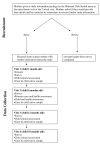The VicGeneration study--a birth cohort to examine the environmental, behavioural and biological predictors of early childhood caries: background, aims and methods
- PMID: 20181292
- PMCID: PMC2847982
- DOI: 10.1186/1471-2458-10-97
The VicGeneration study--a birth cohort to examine the environmental, behavioural and biological predictors of early childhood caries: background, aims and methods
Abstract
Background: Dental caries (decay) during childhood is largely preventable however it remains a significant and costly public health concern, identified as the most prevalent chronic disease of childhood. Caries in children aged less than five years (early childhood caries) is a rapid and progressive disease that can be painful and debilitating, and significantly increases the likelihood of poor child growth, development and social outcomes. Early childhood caries may also result in a substantial social burden on families and significant costs to the public health system. A disproportionate burden of disease is also experienced by disadvantaged populations.
Methods/design: This study involves the establishment of a birth cohort in disadvantaged communities in Victoria, Australia. Children will be followed for at least 18 months and the data gathered will explore longitudinal relationships and generate new evidence on the natural history of early childhood caries, the prevalence of the disease and relative contributions of risk and protective biological, environmental and behavioural factors. Specifically, the study aims to:1. Describe the natural history of early childhood caries (at ages 1, 6, 12 and 18 months), tracking pathways from early bacterial colonisation, through non-cavitated enamel white spot lesions to cavitated lesions extending into dentine.2. Enumerate oral bacterial species in the saliva of infants and their primary care giver.3. Identify the strength of concurrent associations between early childhood caries and putative risk and protective factors, including biological (eg microbiota, saliva), environmental (fluoride exposure) and socio-behavioural factors (proximal factors such as: feeding practices and oral hygiene; and distal factors such as parental health behaviours, physical health, coping and broader socio-economic conditions).4. Quantify the longitudinal relationships between these factors and the development and progression of early childhood caries from age 1-18 months.
Discussion: There is currently a lack of research describing the natural history of early childhood caries in very young children, or exploring the interactions between risk and protective factors that extend to include contemporary measures of socio-behavioural factors. This study will generate knowledge about pathways, prevalence and preventive opportunities for early childhood caries, the most prevalent child health inequality.
Figures
Similar articles
-
Cohort Profile: The VicGeneration (VicGen) study: An Australian oral health birth cohort.Int J Epidemiol. 2017 Feb 1;46(1):29-30. doi: 10.1093/ije/dyw024. Int J Epidemiol. 2017. PMID: 27143137 No abstract available.
-
Splash!: a prospective birth cohort study of the impact of environmental, social and family-level influences on child oral health and obesity related risk factors and outcomes.BMC Public Health. 2011 Jun 27;11:505. doi: 10.1186/1471-2458-11-505. BMC Public Health. 2011. PMID: 21708037 Free PMC article.
-
Early childhood feeding practices and dental caries in preschool children: a multi-centre birth cohort study.BMC Public Health. 2011 Jan 12;11:28. doi: 10.1186/1471-2458-11-28. BMC Public Health. 2011. PMID: 21223601 Free PMC article.
-
Early childhood caries, primary caregiver oral health knowledge and behaviours and associated sociological factors in Australia: a systematic scoping review.BMC Oral Health. 2021 Oct 13;21(1):521. doi: 10.1186/s12903-021-01887-4. BMC Oral Health. 2021. PMID: 34645446 Free PMC article.
-
Promoting oral health from birth through childhood: prevention of early childhood caries.MCN Am J Matern Child Nurs. 2008 Jan-Feb;33(1):17-23; quiz 24-5. doi: 10.1097/01.NMC.0000305652.01743.8d. MCN Am J Matern Child Nurs. 2008. PMID: 18158522 Review.
Cited by
-
Natural history of dental caries in very young Australian children.Int J Paediatr Dent. 2016 May;26(3):173-83. doi: 10.1111/ipd.12169. Epub 2015 May 13. Int J Paediatr Dent. 2016. PMID: 25967851 Free PMC article.
-
The knowledge and practice of pediatricians in children's oral health: a scoping review.BMC Oral Health. 2020 Jul 25;20(1):211. doi: 10.1186/s12903-020-01198-0. BMC Oral Health. 2020. PMID: 32711481 Free PMC article.
-
Natural history of dental caries: Baseline characteristics of the VicGen birth cohort study.Int J Paediatr Dent. 2020 May;30(3):334-341. doi: 10.1111/ipd.12609. Epub 2020 Jan 2. Int J Paediatr Dent. 2020. PMID: 31850608 Free PMC article.
-
Breastmilk influences development and composition of the oral microbiome.J Oral Microbiol. 2022 Jul 5;14(1):2096287. doi: 10.1080/20002297.2022.2096287. eCollection 2022. J Oral Microbiol. 2022. PMID: 35832839 Free PMC article.
-
Knowledge, attitudes and self-reported practices toward children oral health among mother's attending maternal and child's units, Salé, Morocco.BMC Public Health. 2018 May 11;18(1):618. doi: 10.1186/s12889-018-5542-2. BMC Public Health. 2018. PMID: 29751753 Free PMC article.
References
-
- Mouradian WE. The face of a child: children's oral health and dental education. Journal Of Dental Education. 2001;65(9):821–831. - PubMed
-
- Armfield JM, Roberts-Thomson KF, Spencer AJ. Adelaide: The University of Adelaide (AIHW Dental Statistics and Research Series No. 27) Armfield A; 2003. The Child Dental Health Survey, Australia 1999: Trends across the 1990's. AIHW Cat. No. DEN 95; pp. 1–53.
-
- De Grauwe A, Aps JK, Martens LC. Early Childhood Caries (ECC): what's in a name? Eur J Paediatr Dent. 2004;5(2):62–70. - PubMed
-
- Reisine S, Douglass JM. Psychosocial and behavioral issues in early childhood caries. Community Dentistry and Oral Epidemiology. 1998;26(1 Suppl):32–44. - PubMed
Publication types
MeSH terms
LinkOut - more resources
Full Text Sources
Medical



